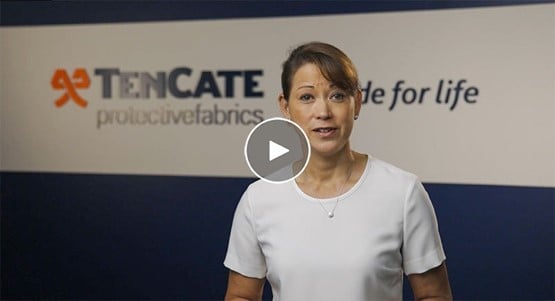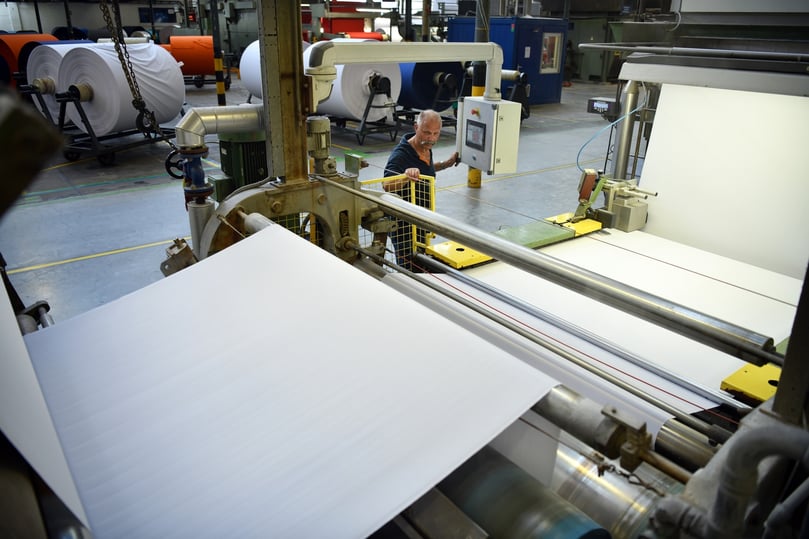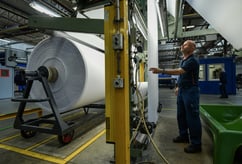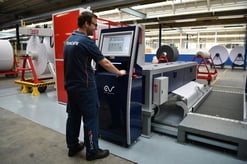Perhaps you’re looking for a quick way to compare prices, or a guide to navigate protective fabrics costs. Pricing can be a bit of a mystery — what exactly are you paying for? In this blog we’ll take you behind the price tag and into the work that goes into our FR protective fabrics, from start to finish. The bottom line: when it comes to safety, you get what you pay for.
Let’s start the tour
Allow us to take you on a virtual tour of our state-of-the-art production facilities in Northwest Europe! As you’ll see, the production process itself is labor-intensive and highly complex, involving specialized technology at each step — all of which is necessary to deliver high-quality fabrics that fully protect your employees.

Spinning
To begin, different fibers such as cotton, modacrylics, aramids, recycled polyester or lyocell (to name a few) are mixed together into a uniform blend before being spun into yarn. At TenCate Protective Fabrics, we have a wide variety of blends, suited for many different end user needs.
Weaving
Next, the yarn is woven into raw fabric. The tightness or looseness of the weave corresponds to the type of performance and protection each fabric is designed to provide.
Pre-treatment of raw cloth
The surface of the raw fabric is smoothed, then the cloth is washed and bleached in preparation for dyeing.
Dyeing
The fabric is given a new color in a dye bath, a process which can take up to 24 hours depending on the fiber type. Dyeing inherent FR fibers such as modacrylics and aramids, for instance, is much more time-intensive than cotton or polyester. Afterwards, the fabric receives a fixing treatment to guarantee superior colorfastness.
FR treatment
The fabric is treated with a finish that makes it flame-retardant, protecting workers from heat stress and flame-related work hazards. (This step is for our FR-treated products. Inherent FR fabrics get their flame-retardancy from their fibers, not an FR finish.)

Finishing
A variety of additional finishes can be applied to provide crease-resistance or give the fabric water-, chemical- or oil-repellent properties. This is followed by a treatment helping the finish to adhere even better to the fibers.
Sanforising
The fabric is treated to prevent it from shrinking during industrial laundering at high temperatures. Consistent fit is very important when it comes to protective clothing!
Inspecting & Packaging
In this final step, every single meter of fabric is inspected for errors and color inconsistencies, then cut into perfectly homogenous rolls — ready to be stitched into high-performing protective workwear garments.
 |
 |
 |
The world behind the price tag
Cutting corners on safety is never a good idea: you get the safety, quality and performance that you pay for. As you’ve seen above, we produce our products with the utmost care at TenCate Protective Fabrics. There are many different elements driving costs in each stage of the process, not to mention the fact that it takes between 3 to 6 months to produce our fabrics from start to finish. At each step, we’re proud to meet high standards of external certification, along with the demands of our own strict quality control. All of this is expressed in the price tag you see on our products.
Don’t let protective clothing pricing remain a mystery for you! We have the broadest FR portfolio in the market: a wide range of both FR-treated and inherent FR fabrics at all price levels. Do not hesitate to contact us for the best solution; schedule an appointment with an end user expert.


.png?width=1080&name=FR%20treated%20or%20inherent%20FR%20what%20is%20the%20difference%20(3).png)


.png?width=399&name=Untitled%20design%20(50).png)



